Incumbent MPs
- Michael Hodgman (LIB), since 2001. Previously MLC for Huon 1966-1974, federal Member for Denison 1975-1987, state Member for Denison 1992-1998.
- Grame Sturges (ALP), since 2002. Minister for Infrastructure.
- David Bartlett (ALP), since 2004. Premier of Tasmania.
- Lisa Singh (ALP), since 2006. Minister for Corrections and Consumer Protection and Minister for Workplace Relations.
- Cassy O’Connor (GRN), since 2008*.
*O’Connor filled a casual vacancy caused by the resignation of Greens leader Peg Putt, who had been Member for Denison since 1993.
Geography
Denison covers the suburbs of Hobart on the western shores of the Derwent River. The seat covers Hobart and Glenorchy LGAs as well as northern parts of Kingborough LGA. The seat includes the Hobart CBD and is by far the most compact seat in Tasmania.
Redistribution
The redistribution enlarged Denison by extending the southern border to the Huon Highway.
History
Denison was first created as a state electorate in 1909, when Tasmania moved to a system of proportional representation with each district electing six members. Denison has always had the same boundaries as the federal electorate of the same name.
The seat first elected four Anti-Socialists and two Labor MPs in 1909. The 1912 election produced an even split of 3 Labor and 3 Liberals, which was maintained at the next four elections. At the 1925 election, the ALP won four out of six seats, as part of ALP’s first majority government in Tasmania, led by Premier Joseph Lyons.
Denison reverted to a 3-3 split in 1928, before the Nationalists won a 4-2 split as part of their landslide win in 1931. The 1934 election saw the ALP recover and they won 3 seats in Denison, alongside two Nationalists and one independent, George Carruthers, who supported an ALP minority government.
The ALP won a more decisive victory in 1937, which saw 4 Labor MPs elected in Denison. This was maintained in 1941, and an independent won a seat off the ALP in 1946, producing a 3-2-1 split. The 1948 election saw three Labor, one Liberal and two independents win seats in Denison.
One of those independent seats was won back by the Liberal Party in 1950, and the 1955 and 1956 elections saw a result of 3 Labor and 3 Liberal MPs in Denison. These two elections produced identical results where the two parties won three seats each in all five districts. This took place despite the ALP winning approximately 7% more than the Liberals at both elections. This ended with the House of Assembly being increased to thirty-five seats at the 1959, when an independent won the seventh seat in Denison.
The Liberal Party won a 4-3 majority in 1964 and 1969, which helped end the Labor government which ruled Tasmania from 1934 to 1969. Denison’s seventh seat went back to the ALP in 1972, when Labor won a majority in Tasmania, but the ALP government managed to win a majority in 1976 despite the Liberals winning the seventh seat in Denison.
The 1979 election gave the Labor government of Doug Lowe a 20-15 majority, including four seats in Denison. The result, however, was invalidated later in 1979 due to violations of campaign spending laws, and a by-election was held in early 1980, which saw two key events that shaped Tasmanian politics. Along with three Labor and three Liberal MPs, the seventh seat was won by Norm Sanders of the Democrats. In addition, internal conflict in the ALP saw the party’s Left hand out how-to-vote cards putting Deputy Premier Neil Batt fourth on their ticket, which led to the introduction of Robson Rotation.
The 1982 election was a landslide for the Liberal Party, who won a 19-14-2 majority in the House of Assembly. Sole Democrats MP Norm Sanders was re-elected in Denison along with four Liberals and two Labor MPs. This was the only time during the period of Denison electing seven MPs that either major party failed to elect at least three MPs in Denison. Director of the Tasmanian Wilderness Society Dr Bob Brown also won 8% of the vote as an independent.
Sanders resigned from Parliament in late 1982 at the height of the Franklin Dam campaign, and Brown won Sanders’ seat on a countback of votes from the previous election.
At the 1986 election Brown was reelected as a “Green Independent”, alongside three from each of the major parties. This pattern of 3 Labor, 3 Liberal and 1 Green was maintained until the reduction in the size of the House of Assembly in 1998, with Brown being succeeded by Peg Putt in 1993.
After two periods of minority governments with the balance of power being held by the Greens, the Labor and Liberal parties agreed to cut the number of seats at the 1998 election from 35 to 25, with each district electing five MPs. The 1998 election saw the ALP and Liberal Party lose a seat in Denison, with Peg Putt surviving as the only Tasmanian Greens MP.
The 2002 election saw the reelection of the Labor government led by Denison MP Jim Bacon, and it saw the Liberal Party reduced to a sole seat in Denison, alongside one Green and three Labor MPs. This result was maintained at the 2006 election.
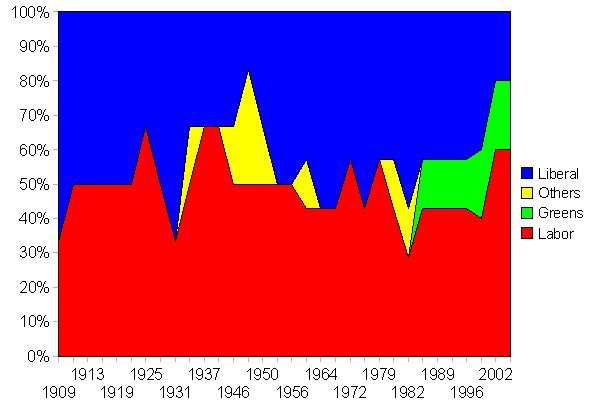
Candidates
- Group A
- Andrew Wilkie (IND), former intelligence whistleblower and Greens federal candidate for Bennelong (2004) and Tasmanian Senate (2007).
- Group B (ALP)
- David Bartlett (ALP)*, Premier of Tasmania
- Lisa Singh (ALP)*, Minister for Corrections and Consumer Protection and Minister for Workplace Relations.
- Graeme Sturges (ALP)*, Minister for Infrastructure.
- Madeleine Ogilvie (ALP)
- Scott Bacon (ALP), son of former Premier Jim Bacon.
- Group C (LIB)
- Elise Archer (LIB), Hobart City Alderman.
- Jenny Branch (LIB), Glenorchy City Alderman.
- Matthew Groom (LIB), son of former Premier Ray Groom.
- Matt Stevenson (LIB)
- Richard Lowrie (LIB), Glenorchy City Alderman.
- Group D (GRN)
- Cassy O’Connor (GRN)*, Greens lead candidate, sitting MP.
- Helen Burnet(GRN), Deputy Mayor of Hobart
- Kartika Franks (GRN)
- Penelope Ann (GRN)
- Peter Cover (GRN)
- Group E (SA)
- Melanie Barnes (SA)
Political situation
The Greens will safely retain their single seat, so O’Connor shouldn’t have trouble winning re-election. At least one seat will go to a Liberal candidate, although none of the Liberals stand out clearly as the candidate who will win that seat. The ALP should comfortably retain two seats, leaving the seat of Graeme Sturges as possibly vulnerable. Sturges has been gaffe-prone over recent years and was the last candidate elected in 2006.
Both the Liberals and Greens, while aiming to win a second seat, will suffer from a lack of stand-out candidates. None of the Liberals are particularly high-profile or stand out as vote-getters. While O’Connor shouldn’t have trouble retaining the seat held before her by Peg Putt and Bob Brown, the high Greens vote in 2006 was largely driven by Peg Putt, who was the only candidate to win a full quota in primary votes. While Helen Burnet managed to win election as the directly-elected Deputy Mayor of the City of Hobart in 2009, this probably doesn’t make up for the loss of Putt.
Andrew Wilkie does not appear to have much of a chance of winning a seat. He will probably have an impact on the Greens primary vote, but most of that will flow back to the Greens in preferences.
2006 result
| Candidate | Votes | % | Quota |
| David Bartlett | 7,982 | 12.97 | 0.78 |
| Julie Collins | 3,703 | 6.02 | 0.36 |
| Joe Ritchie | 1,449 | 2.35 | 0.14 |
| Lisa Singh | 5,760 | 9.36 | 0.56 |
| Graeme Sturges | 5,922 | 9.62 | 0.58 |
| Louise Sullivan | 4,067 | 6.61 | 0.40 |
| Australian Labor Party | 28,883 | 46.94 | 2.82 |
| Elise Archer | 1,939 | 3.15 | 0.19 |
| Fabian Dixon | 3,596 | 5.84 | 0.35 |
| Michael Hodgman | 7,436 | 12.08 | 0.72 |
| John Klonaris | 1,130 | 1.84 | 0.11 |
| Richard Lowrie | 2,239 | 3.64 | 0.22 |
| Liberal Party | 16,340 | 26.55 | 1.59 |
| Marrette Corby | 371 | 0.60 | 0.04 |
| Bill Harvey | 364 | 0.59 | 0.04 |
| Cassy O’Connor | 2,426 | 3.94 | 0.24 |
| Peg Putt | 11,338 | 18.42 | 1.11 |
| Toby Rowallan | 313 | 0.51 | 0.03 |
| Tasmanian Greens | 14,812 | 24.07 | 1.44 |
| Kevin Pelham | 190 | 0.31 | 0.02 |
| Eric Zeppenfeld | 135 | 0.22 | 0.01 |
| Tasmania First | 325 | 0.53 | 0.03 |
| Linda Seaborn | 237 | 0.39 | 0.02 |
| Socialist Alliance | 237 | 0.39 | 0.02 |
| Michael Fracalossi | 309 | 0.50 | 0.03 |
| Paul Glover | 89 | 0.14 | 0.01 |
| Ken Higgs | 43 | 0.07 | 0.00 |
| Group F | 441 | 0.72 | 0.04 |
| Leo Foley | 271 | 0.44 | 0.03 |
| Hugh Miller | 229 | 0.37 | 0.02 |
Booth breakdown
The ALP won their highest numbers in the Glenorchy area, while both the Liberals and Greens performed stronger in the City of Hobart. The ALP won the most votes in every Glenorchy booth, while in Hobart the ALP won 11, the Greens won 13 and the Liberals won 4. The Greens won the sole booth in Kingborough LGA.
Booths have been divided into six suburb areas. The ALP won four of these areas. The ALP won over 60% in Glenorchy, Claremont and Moonah. In New Town and Lenah Valley, the ALP came first with 44% to 26% each for Greens and Liberals. The area around the centre of Hobart was won by the Greens, who polled over 40%. In Sandy Bay and surrounding areas the ALP came third, with the Liberals winning on 36%.
| Voter group | ALP % | LIB % | GRN % | Total votes | % of votes |
| Sandy Bay & South | 28.45 | 36.72 | 32.52 | 11,373 | 18.48 |
| Hobart | 34.99 | 20.81 | 41.44 | 9,719 | 15.79 |
| Glenorchy | 62.19 | 24.15 | 11.56 | 9,247 | 15.03 |
| Claremont | 67.22 | 20.71 | 9.94 | 7,928 | 12.88 |
| New Town & Lenah Valley | 44.05 | 26.64 | 26.79 | 5,991 | 9.74 |
| Moonah | 60.44 | 21.93 | 14.61 | 5,960 | 9.69 |
| Other votes | 43.51 | 29.71 | 24.31 | 11,320 | 18.40 |
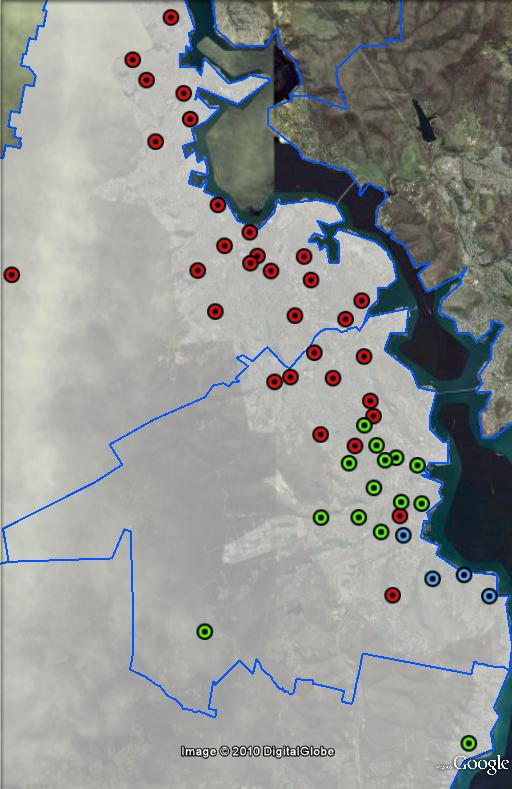
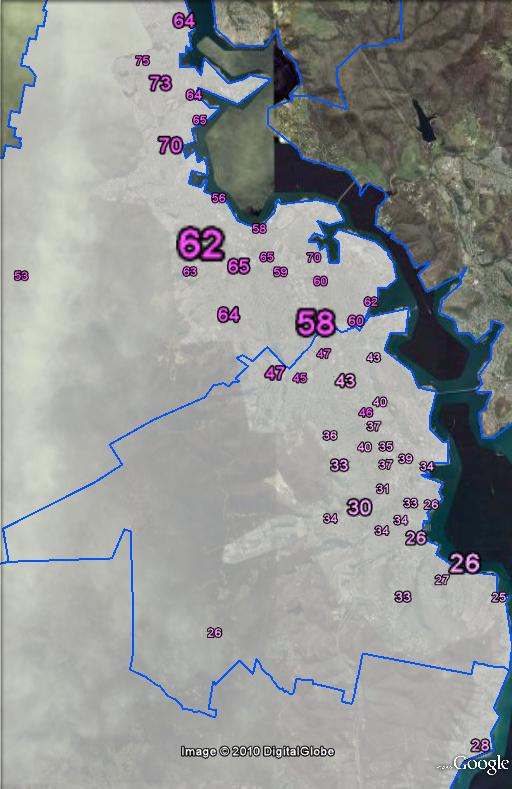
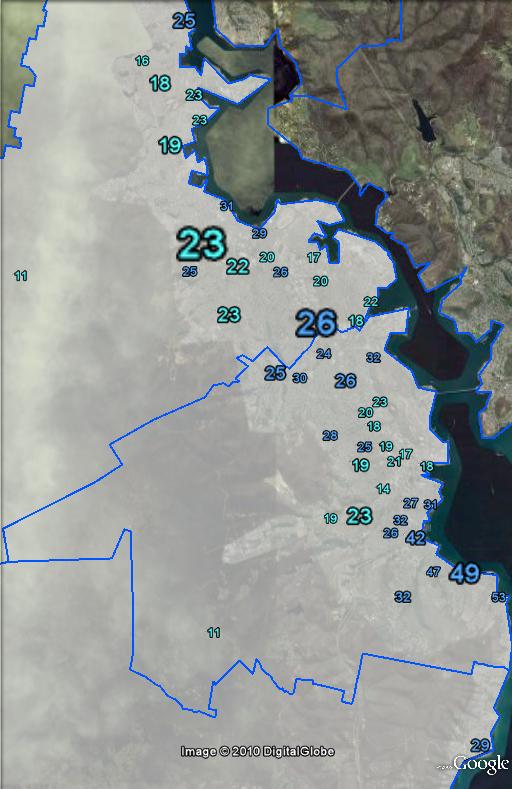
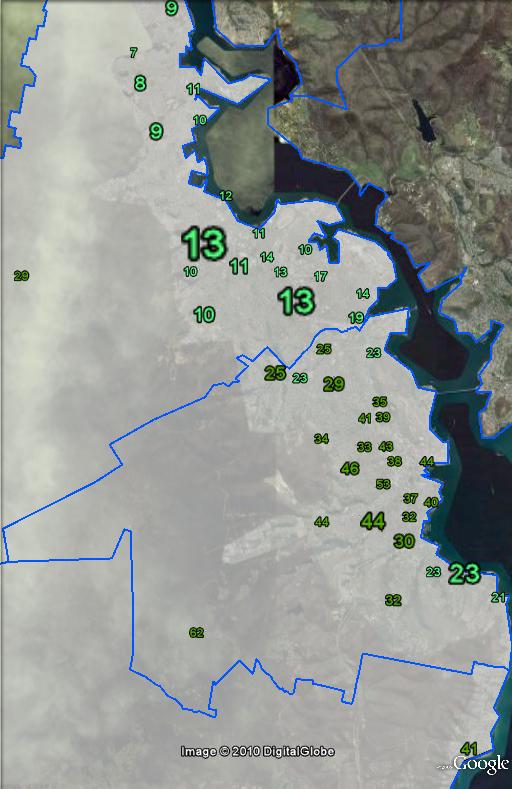


Denison is an interesting seat this time around, which could throw up a few possible options.
Firstly, the last EMRS poll for Denison had the Lib/Lab/Green/Wilkie split as 43/27/27/3, which in a strictly proportional system would probably wash out as 2/2/1 after the campaign dirt is slung.
It will be more intersting though because of the Hare-Clark system. Simply, the Libs don’t have any big vote pullers and I expect we will see a lot of Lib candidates floating around the half quota mark, which would splinter their vote and up the chance of exhaustion and thus a surprise candidate getting up. Labor, conversely, have three sitting members battling for votes. One would imagine that Bartlett will gain the lions share and poll over a quota in his own right, though it is worth noting that the Housing Commission areas of Glenorchy are very loyal to Sturges, which may see him hold on against Singh for the second Labor seat. I can’t see Labor holding 3 seats. One would also expect most of the Green vote to go to the sitting MP, with Burnet to probably pull about 4% and the rest to pull little between them.
With only 2 MPs likely to get a quota in their own right (O’Connor and Bartlett), I can’t rule out Wilkie, who could potentially gain preferences from early excluded Greens and I also think from early excluded Libs (Wilkie is from Sandy Bay), which if pushed him ahead of Burnet would give him a real chance.
However, my tip remains, in order of election, Bartlett, O’Connor, Archer, Singh & Groom with Wilkie to come 6th or 7th.
hey Ben,
although the Tasmanian state election was quite a while ago now, I feel here might be an appropriate place to mention that on the 7th August 2010 (2 weeks out from the federal election) I (just) received a facebook friend request from Madeleine Ogilvie.
I’d never heard of her, so I looked at our mutual friends – without disclosing any personal details I think it would be ok if I revealed the political affiliations of the 31 mutual facebook friends I share with her:
Of those 31 people, 28 are either current or former members of the Greens (not sure if all them are necessarily currently paid up financial members), 2 are FoE campaigners (not sure if either of them happen to be or if they have ever been Greens members) & the other was at least an ALP member once but not sure if they’re a current paid up member.
Bizarre.